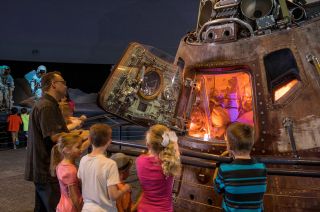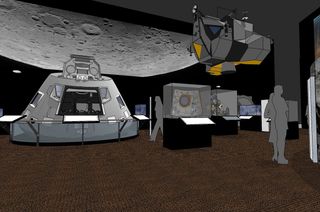'Destination Moon': Museums and Science Centers Plan for Apollo 11 Exhibit

For Houston, it will be a homecoming; for St. Louis, a product of its past. In Pittsburgh, it will be seen as a symbol of innovation; and in Seattle, an arrival worthy of a celebration.
Columbia, the Apollo 11 command module that carried the first astronauts to walk on the moon, will embark on a two-year tour to the four U.S. cities as part the National Air and Space Museum's biggest, most ambitious traveling exhibit to date.
"Destination Moon: The Apollo 11 Mission" will premiere at Space Center Houston in Texas this fall. It will then ship by way of FedEx transport to the Saint Louis Science Center in Missouri and the Senator John Heinz History Center in Pennsylvania. Finally, Columbia and 20 other objects from the first moon landing will arrive at The Museum of Flight in Washington in 2019, in time to go on display for the 50th anniversary of the Apollo 11 mission. [How the Apollo 11 Moon Landing Worked (Infographic)]
The four sites were selected by the Smithsonian Institution Traveling Exhibition Service (SITES), in part for their ability to care for the spacecraft while it is on display. But beyond the curatorial logistics, the locations will also add their own influences to the exhibition of Columbia, drawing from their geographically-diverse audiences and differing focuses.
Houston, Columbia has landed
Space Center Houston may not have landed "Destination Moon" for the Apollo 11 50th anniversary in July 2019, but debuting Columbia on Oct. 14 will still mark a milestone.
"We're going to be opening the exhibit two days before our actual 25th anniversary date," said William Harris, CEO of Space Center Houston. "For us it's the perfect item to have to celebrate our jubilee year."
"It will be a wonderful way to commemorate what we're all about," he said.
Get the Space.com Newsletter
Breaking space news, the latest updates on rocket launches, skywatching events and more!
The only NASA visitor center among the museums that the command module will visit, Space Center Houston has told the history of the space agency's past achievements since 1992. Columbia's display, through March 18, 2018, will cap that legacy, as the center looks toward to its next 25 years.
"Bringing Apollo 11 here is so significant. In some ways, it is an end cap to our pivot," Harris told collectSPACE. "Our organization has been very history-oriented looking at the U.S. space program. But now, as we achieve our 25th year in service to the public, we're now really pivoting to what to what is going on now and where are we going in space."
Occupying the exhibit space at the center of Space Center Houston's main hall, "Destination Moon" will be bordered by the present — a permanent exhibit about the International Space Station; the future — a new interactive exhibit about NASA's exploration of Mars; and the past.
"What's so exciting for us is that where we're going to have Apollo 11, we have nearby the podium that Kennedy stood at to challenge the nation to choose to moon and we have the Apollo 17 command module that took the last humans to the moon in the Apollo era," said Harris.
"We have a lot of Apollo-era artifacts already on exhibit, so our venue will be different than any other, just because of the nature of who we are and what we have," he said.

Gateway to the moon
"Destination Moon" is scheduled to open at the Saint Louis Science Center on April 14, 2018, and continue on display until Sept. 3 of that year. As such, Columbia will spend the 49th anniversary of its Apollo 11 mission in Missouri.
"Personally, my 49th birthday was as special as my 50th. So, if that is anything to go on, we will make it something special," said Bert Vescolani, the president and CEO of the Saint Louis Science Center.
Columbia will go on exhibit in the Science Center's Boeing Hall, named for the aerospace giant that today owns the company that built the Apollo 11 command module, North American Aviation. Boeing also acquired St. Louis-based McDonnell Douglas, which was NASA's contractor for the Mercury and Gemini spacecraft.
"Mercury and Gemini played a big role in the development, shape and formation of what later became Apollo," said Vescolani. "We're so prideful that St. Louis played a part in that history — at that time it was McDonnell, now Boeing — and how important that role was for our region."
The Science Center plans to present "Destination Moon" to that it highlights the contributions of the community.
"I think that it is important for us to tell the story within a St. Louis context, or even a midwest context, and talk about the importance of this region," Vescolani said. "The history here is so amazing and it is still a living history. We have a rich tradition in this community."
The rare chance to see Columbia outside the Smithsonian is expected to draw visitors to the center, Vescolani said.
"Because it is only in four locations and because it is such a historical artifact and has a story that is so ingrained in popular culture and pride, I do believe we'll get a broader midwest representation," he said. "There are a lot of space enthusiasts out there who may not be able to make it to D.C. to see it, or haven't been able to over the years, and this may be their only opportunity."

Steely-eyed moon men
The next stop on the "Destination Moon" tour will take the Apollo 11 spacecraft to Pittsburgh and the largest history museum in the Commonwealth of Pennsylvania.
"[We are] the only history museum in the tour line-up. The others are science museums or museums of flight," Andy Masich, the CEO of the Senator John Heinz History Center said in an interview with collectSPACE.
Like in St. Louis, the Heinz History Center also intends to use Columbia's display, from Sept. 29, 2018 through Feb. 18, 2019, as a means to showcase the area's connection to the Apollo program.
"We are going to be talking about the industry, the hard work behind the space race that came from Pittsburgh," Masich said. "North American Rockwell created the Apollo 11 command module Columbia; Alcoa aluminum was used extensively in the lunar lander and just about every part of the Apollo mission equipment. Westinghouse Electric was responsible for making possible the images that Armstrong and Aldrin sent back to Earth."
"We will also even talk about some of the specialty steels that went into some of the equipment," he said.
The first venue to host Columbia during the Apollo 11 50th anniversary year, the History Center intends to emphasize the local tradition of innovation and the role that science, technology and engineering made to mission success.
"The thing that Pittsburgh is famous for is that kind of 'we can do it' spirit that characterized the entire mission," said Masich. "The idea of putting a man on the moon within a decade that President Kennedy challenged the nation with is just the kind of challenge that Pittsburgh and Pittsburgh industry was ready to roll up its sleeves and take on."
Masich said he was also taking on the challenge to learn if ketchup flew on Apollo 11, in a nod to the History Center's namesake and another of center's exhibits devoted to the food processing company.
"Destination Moon" will be displayed in the Heinz Center's McGuinn Gallery, its largest gallery for traveling exhibits. [Space Food Evolution: How Astronaut Chow Has Changed (Photos)]
Half-centennial in 'Jet City'
"We're incredibly excited to have this exhibit coming to the museum and we're especially excited about the fact that it will be at The Museum of Flight for the 50th anniversary of the Apollo 11 landing," said Geoff Nunn, adjunct curator for space history at the Seattle museum. "It's an honor and an absolute thrill, and we can't wait to be able to share these historic artifacts on the West Coast."
"Destination Moon" will be displayed at its final venue from March 16 to Sept. 2, 2019, after which Columbia will return to the National Air and Space Museum.
Unlike the other three locations, where dedicated traveling exhibit halls will host the Apollo 11 artifacts, Columbia will be moving into The Museum of Flight's T.A. Wilson Great Gallery, where "Apollo" is currently under construction.
"We will be opening our own 'Apollo' exhibit on May 20 of this year, and then we want to have events and possibly some other small exhibits that we're still planning, leading up to arrival of 'Destination Moon' in 2019, to create this continuum celebrating the 50th anniversary," said Nunn.
That continuity, however, will require some tradeoffs once the Smithsonian exhibition arrives.
"I believe the plan right now is that Columbia will take the place of our command module, CM-007A, for the duration of the 'Destination Moon' visit," Nunn told collectSPACE. "We are still working out which other items we are going to swap with items in our permanent collection and which we are going to be displayed alongside."
The Museum of Flight intends to highlight both the area's connections to Apollo history and Seattle's current role as the "burgeoning hub of 'New Space' activity."
"It is a nice blend of past and present, which is something we are very excited about," Nunn said. "I think we are just getting rolling, wrapping our heads around exactly how we are going to maximize the impact of having the Apollo 11 artifacts here.”
Read more about the "Destination Moon" traveling exhibit at collectSPACE: Smithsonian to launch Apollo 11 Columbia spacecraft on national tour.
Follow collectSPACE.com on Facebook and on Twitter at @collectSPACE. Copyright 2017 collectSPACE.com. All rights reserved.
Join our Space Forums to keep talking space on the latest missions, night sky and more! And if you have a news tip, correction or comment, let us know at: community@space.com.

Robert Pearlman is a space historian, journalist and the founder and editor of collectSPACE.com, a daily news publication and community devoted to space history with a particular focus on how and where space exploration intersects with pop culture. Pearlman is also a contributing writer for Space.com and co-author of "Space Stations: The Art, Science, and Reality of Working in Space” published by Smithsonian Books in 2018.In 2009, he was inducted into the U.S. Space Camp Hall of Fame in Huntsville, Alabama. In 2021, he was honored by the American Astronautical Society with the Ordway Award for Sustained Excellence in Spaceflight History. In 2023, the National Space Club Florida Committee recognized Pearlman with the Kolcum News and Communications Award for excellence in telling the space story along the Space Coast and throughout the world.










